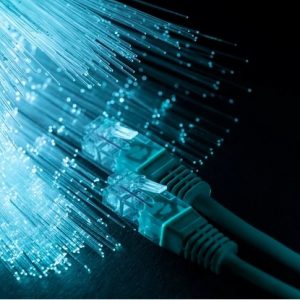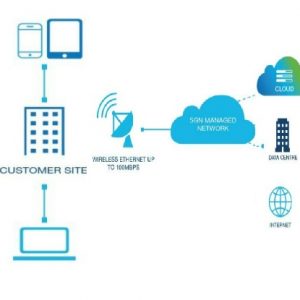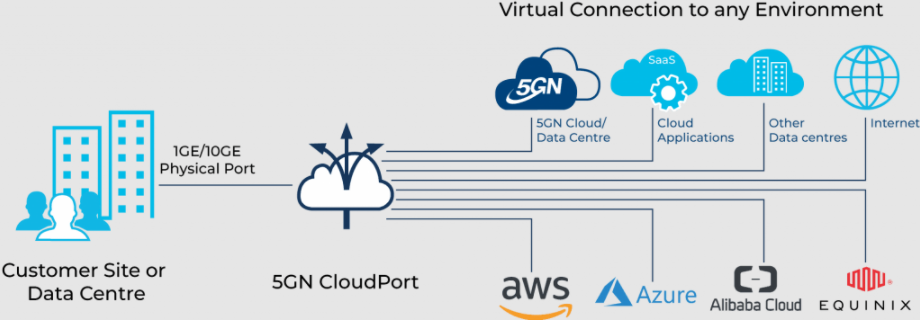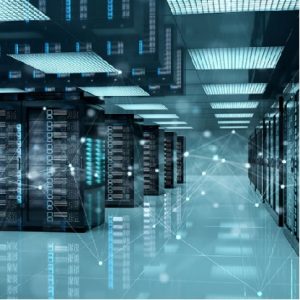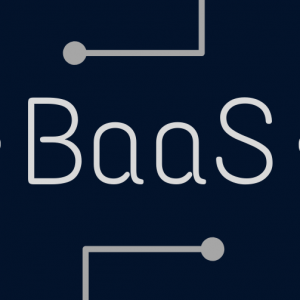Telecommunication Glossary of Terms and Definitions
What is Ethernet?
Ethernet is a conventional technology for linking devices in a wired local area network (LAN) or wide area network (WAN), allowing them to interact with one another using a protocol, which is a set of rules or a common network language. Ethernet is a network protocol that explains how network devices structure and send data so that other devices on the same local or campus area network segment can recognise, receive, and process it. The actual, encased wiring over which data passes is known as an Ethernet cable.
Ethernet is a versatile approach to connect to your data and applications at ultra-high speeds and with the least amount of latency.
Click here for more information and how to get Ethernet
Ethernet Key Features
5GN Ethernet Services are transparent Layer 2 services offering:
- Point-to-point connectivity
- Point-to-Multipoint connectivity (hub-and-spoke, any-to-any)
- Speeds from 20Mbps through to 10Gbps
- Guaranteed bandwidth without any network contention
- A dedicated service to a single customer
- MEF (Metro Ethernet Forum) compliant services
- Secure, fully redundant (diverse path) fibre backhaul connecting our nationwide IP/MPLS network.
- Metro, National and International coverage
What is Wireless Ethernet?
Wireless Ethernet is a wireless networking protocol that can be used in a business or at home. A WiFi network is another name for it. It’s a popular wireless Ethernet alternative. It communicates and transmits data via high-frequency radio waves. The advantages of using a wireless LAN over a wired network connection include installation flexibility, better productivity, scalability, lower cost of ownership, and quick and easy network setup. Ethernet ports, wireless NICs, hubs, and switches make up a wireless Ethernet network. Click here for more information and how to get Wireless EthernetWireless Ethernet Key Features
- Available Bandwidth– 10Mbps-100Mbps (Symmetrical)
- Contention ratio – 1:1 (guaranteed)
- Quality of Service (QOS) – Support for 4 QOS queues (1 Expedited + 3 others) – Customer required to mark their traffic with DSCP.
- Transport type – Layer 2
- Technology Type Microwave – 5Ghz Licensed spectrum
- Backhaul Transit – Dedicated Fibre backhauls from our Wireless Ethernet Point of Presence (POP) sites connecting to the 5GN Data Centres.
- Customer Handoff – Cat-6 Ethernet or Single Mode Fibre
- Coverage Area – Melbourne CBD & Surrounds
- Monitoring – 24 x7 x 365 Days
- Assurance Service Level – 1 hour response, 12-hour MTTR**
What is Premium Ethernet?
Wireless Ethernet is a wireless networking protocol that can be used in a business or at home. A WiFi network is another name for it. It’s a popular wireless Ethernet alternative. It communicates and transmits data via high-frequency radio waves. The advantages of using a wireless LAN over a wired network connection include installation flexibility, better productivity, scalability, lower cost of ownership, and quick and easy network setup. Ethernet ports, wireless NICs, hubs, and switches make up a wireless Ethernet network. Click here for more information and how to get Premium Ethernet- Available Bandwidth – Up to 10Gbps*
- Contention ratio – 1:1 (guaranteed)
- Quality of Service (QOS) – Support for 4 QOS queues (1 Expedited + 3 others) – Customer required to mark their traffic with DSCP.
- Transport type – Transport Layer 2 access into the 5GN Private Core Network.
- Technology Type – Ethernet over Fibre and Copper
- Backhaul Transit – Secure, fully redundant (diverse path) nationwide fibre backhaul connecting our nationwide Point of Presence (POP) sites
- Coverage Area – Nationwide. POP sites in Sydney, Melbourne, Brisbane, Adelaide and Perth.
- Monitoring – 24 x7 x 365 Days
- Target Assurance Service Level – 1 hour response, 12 hour MTTR**
What is CloudPort?
5GN CloudPort provides scalable connectivity between multiple data centres, clouds and network environments. CloudPort enables the creation of private point-to-point connectivity by utilising 5GN’s state-of-the-art Ethernet fabric network between a customer connected on any of 5GN’s POPs and a host of DCs, 5GN private cloud, multiple public clouds and other services. Click here for more information and how to get CloudPortWhat is Dark Fibre?
Dark Fibre refers to Network Fibre Optic Cables which have been laid in the ground to physically connect different buildings and data centres. Since digging and laying down cables is a huge investment, 5GN has provisioned significant excess capacity in those cables for them to be leased by different companies. This is unlit and unmonitored passive optical path that requires you to connect your own active equipment at each end.
Route Diversity
Network route diversity is critical to protect your business. You can design a Dark Fibre network that is graphically diverse from other routes you may currently use, or provide a secondary diverse path.
Click here for more information and how to get Dark Fibre
Dark Fibre Key Features
5GN Dark Fibre service provides a dedicated fibre pair to each customer which they can use and manage entirely. The service offers:
- Connectivity to over 80 DCs in major metro areas
- ITU-T G.652 compliant single-mode optical fibre
- Complete privacy and control. Each dark fibre pair is exclusive and the customer can deploy their own equipment for management and control
- The ability to connect near-net buildings and data centres on market demand
- Predictable cost with flexible payment and contract terms
What is IaaS?
Infrastructure as a service or as it is commonly known IaaS is a is a pay-as-you-go cloud computing service that provides critical computer, storage, and networking resources on demand. You may avoid the cost and complexity of purchasing and managing actual servers and datacenter equipment by using IaaS. Each resource is given as a separate service component, and you only pay for it for as long as you require it. IaaS products range from basic website hosting to in-depth data analysis, and businesses can customise packages to meet their specific digital requirements. IaaS, which includes a variety of services and tools for IT administrators, includes Amazon Web Services and Google Compute Engine.Click here for more information and how to get IaaS
IaaS Key Features
So why opt for IaaS? IaaS with 5G Networks offers –
- Fantastic scalability – IaaS makes it easy to increase or decrease aspects of your network in real-time, responding to business needs.
- Cost-effectiveness – IaaS limits the amount of in-house infrastructure needed, allowing you to retain more of your capital to reinvest in other branches of the business.
- Superior IT resources – IaaS makes it possible to enjoy enterprise-level IT resources without financial commitment. Our experts manage your network and address any issues early on, resolving problems before they become apparent.
- Greater resilience – IaaS ensures your business is prepared for the worst case scenario. IaaS cloud infrastructure is hosted in secure, purpose-data centres to enable business continuity and prompt disaster recovery.
What are Point to Point Wavelengths?
Wavelengths are high-capacity data transmission systems that use fibre optics to convey data from one location to another. They’re utilised for core networking between data centres and corporate headquarters, for example. A single strand of fibre optic cable can be broken down into so many wavelength components that it can carry 96 bandwidth channels. This is possible because data is transmitted by several laser transmitters, each with its unique wavelength (frequency).
Click here for more information and how to get Point to Point Wavelength
Wavelength Key Features
- Point to point high speed Wavelengths between 5GN OTN PoPs
- 1.25Gbps to 50Gbps Wavelengths
- OTN, Ethernet, SDH/SONET & Fibre Channel Interfaces
- 10G Ethernet, OTU2/OTU2e interfaces
- Scalable as requirements change
- On premise or datacentre delivery
- AES-256 Encryption Available
- Metro, national and international reach
What is BaaS?
Backend-as-a-Service (BaaS) is a cloud service model in which developers outsource all of the backend parts of a web or mobile application, leaving them with only the frontend to build and manage. Pre-written software for server-side tasks such as user authentication, database administration, remote updating, and push notifications (for mobile apps), as well as cloud storage and hosting, is provided by BaaS suppliers.
Click here for more information on Backend as a Service (BaaS).
BaaS Key Features
- Up to 7 years retention
- One management platform with one self-service across multiple platforms
- Multi cloud Backup (private, public and hybrid workloads)
- Military grade encryption using AES-256 and SSL/TLS
- Backup restore – no additional data charges
What is a Disaster Recovery (DR) plan?
A Disaster Recovery plan can be split into two parts.
Recovery Time Objective (RTO): This is the amount of time after a disaster in which business operation is retaken, or resources are again available for use.
Recovery Point Objective (RPO): RPO can be seen as how much data loss can you afford in terms of time or in terms of amount of information.
Click here for more information on Disaster Recovery Plans (DR).
Disaster Recovery Key Features
- Aims to help minimise potential disaster strikes

What is a Contention Ratio?
The contention ratio is the ratio of greatest possible demand to real bandwidth.
The higher the contention ratio, the more users may be attempting to utilise the real bandwidth at any given moment, and hence the lower the effective bandwidth supplied, especially during peak times.
Click here for more information on Contention Ratios.
Contention Ratio Key Features
- 1:1 Contention ratio guaranteed
- Support for 4 QOS expedited + 3 others.
- Up to 10Gbps bandwidth
- Nationwide coverage premium ethernet.

What is Distributed Denial of Service (DDoS)
- Volumetric Attack: where the goal is to generate enough bandwidth to saturate the bandwidth of the targeted site, with its magnitude being measured in bits per second (bps)
- Protocol Attack: targeted at consuming remote server resources or firewalls and load balancers. These are measured in Packets per second (pps).
- Application Layer Attacks: floods which target known web application vulnerabilities such as an unpatched website. These are measured in requests per second (rps).

What is a Domain Name System (DNS)
This is is the Internet’s method for mapping alphabetic names to numeric Internet Protocol (IP) addresses, in the same way that a phone book maps a person’s name to a phone number.
Click here for more information about Domain Name Systems.
DNS Key Features
- If the host’s IP address changes, it can map to a new IP address.
- DNS allows for ease in memorisation rather than an IP address
- allow businesses to employ a domain name hierarchy that is unrelated to IP address assignment

What is a SIP Trunking Provider
SIP Trunking Key Features
- Direct Number Availability (DID) throughout Australia & New Zealand
- Secured Accounts (All accounts require mandatory registration using username and password)
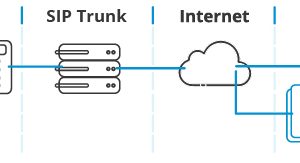
What is Voice Bridge One?
This is a collaborative tool which connects your internal workforce and external partners seamlessly via persistent chat, PSTN dial, voice and video conference, shared presence and SaaS integration.
Click here for more information about Voice Bridge One
Voice Bridge One Key Features
- Manage and grow users quickly, import current phone numbers, and add new numbers.
- One bill that includes unlimited calls to local, national, and mobile phones.


